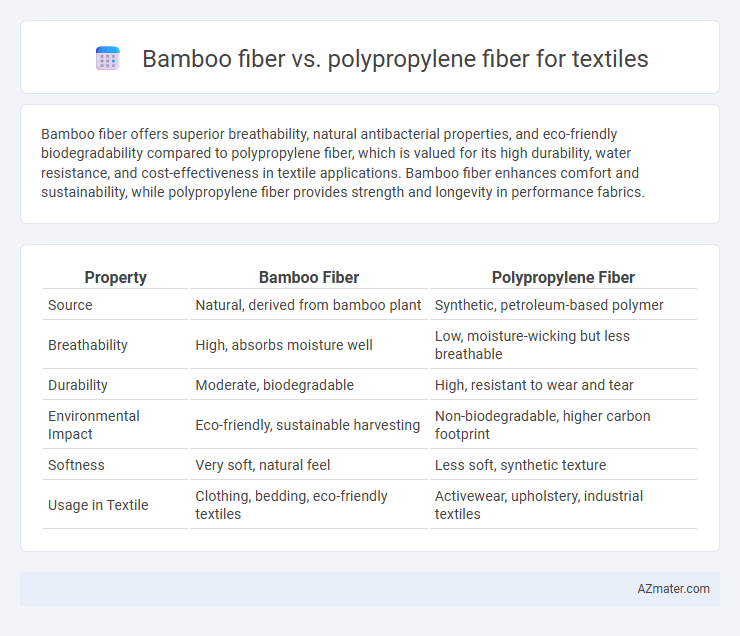Bamboo fiber offers superior breathability, natural antibacterial properties, and eco-friendly biodegradability compared to polypropylene fiber, which is valued for its high durability, water resistance, and cost-effectiveness in textile applications. Bamboo fiber enhances comfort and sustainability, while polypropylene fiber provides strength and longevity in performance fabrics.
Table of Comparison
| Property | Bamboo Fiber | Polypropylene Fiber |
|---|---|---|
| Source | Natural, derived from bamboo plant | Synthetic, petroleum-based polymer |
| Breathability | High, absorbs moisture well | Low, moisture-wicking but less breathable |
| Durability | Moderate, biodegradable | High, resistant to wear and tear |
| Environmental Impact | Eco-friendly, sustainable harvesting | Non-biodegradable, higher carbon footprint |
| Softness | Very soft, natural feel | Less soft, synthetic texture |
| Usage in Textile | Clothing, bedding, eco-friendly textiles | Activewear, upholstery, industrial textiles |
Introduction to Bamboo Fiber and Polypropylene Fiber
Bamboo fiber is a natural, biodegradable textile material derived from the pulp of bamboo plants, prized for its softness, breathability, and antimicrobial properties, making it ideal for eco-friendly and sustainable fabric production. Polypropylene fiber is a synthetic polymer-based textile known for its high strength, moisture-wicking capabilities, and resistance to chemicals and abrasion, widely used in industrial and performance fabrics. In textile applications, bamboo fiber offers environmental benefits and comfort, while polypropylene fiber provides durability and technical performance.
Source and Production Process
Bamboo fiber is derived from the cellulose of bamboo plants, using either mechanical crushing or chemical processing to extract soft fibers suitable for textiles, emphasizing eco-friendly and sustainable methods. Polypropylene fiber is a synthetic material produced from polymerized propylene through a melt-spinning process, relying on fossil fuel-based petrochemical sources and energy-intensive manufacturing. The renewable origin of bamboo fiber contrasts with the non-renewable, petroleum-based nature of polypropylene, affecting their environmental footprints and production complexities.
Physical and Mechanical Properties Comparison
Bamboo fiber exhibits superior moisture absorption and breathability compared to polypropylene fiber, making it ideal for comfortable textile applications. Polypropylene fiber offers enhanced tensile strength and abrasion resistance, contributing to greater durability in high-performance fabrics. The biodegradability of bamboo fiber contrasts with the synthetic nature of polypropylene, affecting environmental impact and end-of-life disposal options.
Environmental Impact and Sustainability
Bamboo fiber outperforms polypropylene fiber in environmental impact due to its natural biodegradability and renewable growth cycle, requiring less water and pesticides during cultivation. Polypropylene fiber, derived from petroleum, poses sustainability challenges with its non-biodegradable nature and reliance on fossil fuels, contributing to microplastic pollution in ecosystems. Choosing bamboo fiber in textiles supports sustainable production and reduces ecological footprint compared to synthetic polypropylene alternatives.
Biodegradability and Eco-Friendliness
Bamboo fiber is highly biodegradable and eco-friendly, breaking down naturally within months due to its organic cellulose content, which reduces landfill waste and environmental pollution. Polypropylene fiber, a synthetic polymer, poses significant biodegradability challenges as it can persist for decades, contributing to microplastic pollution and hindering waste management efforts. Choosing bamboo fiber over polypropylene promotes sustainability in textiles by minimizing ecological impact and supporting circular economy principles.
Comfort and Wearability in Textiles
Bamboo fiber offers superior breathability and moisture-wicking properties, making textiles highly comfortable and soft against the skin, ideal for sensitive or athletic wear. Polypropylene fiber is lightweight and hydrophobic, providing excellent moisture resistance but often lacks the natural softness and breathability, which may reduce overall wearability for prolonged use. Bamboo textiles enhance comfort through natural antimicrobial benefits, while polypropylene fibers excel in durability and quick-drying performance, influencing the choice based on specific textile applications.
Moisture Absorption and Breathability
Bamboo fiber exhibits superior moisture absorption and breathability compared to polypropylene fiber, due to its natural cellulose structure that effectively wicks away sweat and allows air circulation. Polypropylene fiber, being synthetic and hydrophobic, offers limited moisture absorption and traps heat, resulting in reduced breathability. Textile applications favor bamboo fiber for enhanced comfort in moisture management and ventilation, especially in activewear and summer garments.
Durability and Maintenance Requirements
Bamboo fiber offers natural antimicrobial properties and is biodegradable, but it tends to have lower tensile strength and durability compared to polypropylene fiber, which boasts high resistance to abrasion, chemicals, and UV degradation. Polypropylene fiber requires minimal maintenance, with excellent stain resistance and quick-drying capabilities, making it ideal for heavy-use textiles and outdoor applications. In contrast, bamboo fiber demands more careful maintenance, such as gentle washing and avoidance of harsh detergents, to preserve its softness and structural integrity.
Cost-Effectiveness for Manufacturers
Bamboo fiber offers eco-friendly benefits but tends to have higher raw material and processing costs compared to polypropylene fiber, which is cheaper and widely available. Polypropylene fiber's cost-effectiveness for manufacturers stems from its lower production expenses, durability, and ease of mass production, making it ideal for budget-sensitive textile lines. However, bamboo fiber's value lies in premium market segments where sustainability commands higher price points despite increased manufacturing costs.
Applications and Future Trends in Textile Industry
Bamboo fiber offers superior biodegradability, moisture-wicking properties, and antibacterial qualities, making it ideal for sustainable fashion, activewear, and medical textiles, while polypropylene fiber excels in durability, chemical resistance, and cost-effectiveness, suiting industrial textiles, geotextiles, and packaging materials. The future textile industry trends emphasize eco-friendly and smart textiles, driving increased demand for bamboo fiber in biodegradable fabrics and functional garments integrated with natural properties. Innovations in fiber blending and nanotechnology are poised to enhance polypropylene's performance in filtration and composite applications, expanding its role in technical textiles.

Infographic: Bamboo fiber vs Polypropylene fiber for Textile
 azmater.com
azmater.com